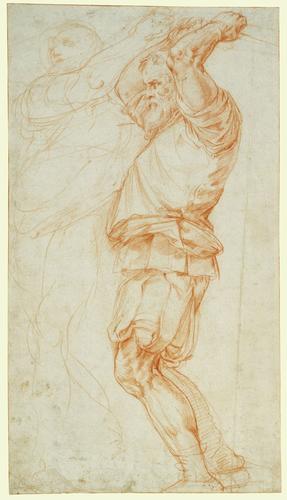Battista Franco (c. 1510-1561)
A flagellator c. 1555
Red chalk | 40.4 x 22.4 cm (sheet of paper) | RCIN 990048
-
A drawing of a bearded man, turned to the left, with his arms raised over his head, holding a flail; a second lightly sketched figure is behind him. Faintly inscribed at lower left, pencil: 'Battista Franco'.
The figure is a study (in reverse) for a tormentor in Franco’s engraving of the Flagellation (Bartsch XVI, p.122, no.10; a reversed copy is at RCIN 830517). The details agree closely with the print, though the waistband is reduced in width, a cloak is added, and the figure is tilted back a little.
Franco's print is signed ‘Batista Franco facciebat’ but does not record the inventor of the composition, and it has been suggested that it reproduces a lost painting by Titian, such as that described by Giorgio Vasari as having been sent to the Queen of Portugal. In the Metropolitan Museum, New York, is a comparable red-chalk study for the figure of Christ in the same composition; that drawing is a nude study to which Franco later added the loincloth and the usual facial features of Christ, including a beard. amendments that seem to confirm that Franco was not copying a painting but was devising the figures afresh, and he must be credited with the invention.
The print is datable to early in Franco’s final Venetian period. Van der Sman (Le Siècle de Titien, Gravures vénetiennes de la Renaissance, 2002-3, p.162) raised the possibility that Franco conceived the composition as a painting and later decided to render it in a print. The handedness of the figures does not help to resolve the matter - the two flagellators seen here are left-handed in the drawing, right-handed in the print; the other two nearest Christ are left-handed in the print, but this may simply have been a compositional device to maintain an open and inward direction to their poses and actions. Both studies are a little larger than the corresponding figures in the print, and there is no evidence of mechanical transfer (such as incised outlines) to or from these sheets. Nonetheless, the appropriateness of scale and conception of these figures for a typical late, large print by Franco would support the simpler contention, that the composition was intended from the outset to be engraved.Provenance
Presumably in the Royal Collection by c.1810
-
Creator(s)
-
Medium and techniques
Red chalk
Measurements
40.4 x 22.4 cm (sheet of paper)










